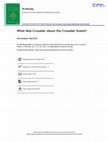Papers by Christopher MacEvitt
Baldwin of Boulogne was acclaimed the ruler by a rebellious faction of the population, it had van... more Baldwin of Boulogne was acclaimed the ruler by a rebellious faction of the population, it had vanished by 1150, when its remaining lands passed to the Byzantine emperor Manuel I Comnenus. The brevity of the county's existence, however, is belied by its long afterlife among Eastern Christian communities.
The Martyrdom of the Franciscans: Islam, the Papacy, and an Order in Conflict

Processing together, celebrating apart: shared processions in the Latin East
Journal of Medieval History, 2017
ABSTRACT Twelfth-century narrative accounts in Armenian, Syriac and Latin recount a number of pro... more ABSTRACT Twelfth-century narrative accounts in Armenian, Syriac and Latin recount a number of processions in Syria and Palestine in which both Eastern Christians and Latins participated. Processions were one of the many ways by which the Franks expressed their political dominance over the urban (and likely also the rural) landscape, but it was also a way that all Christian communities used to express and even construct relationships among themselves. Scholars often assume that the procession performs (in a Durkheimian sense) the work of creating or displaying unity. Yet the scattered sources of the twelfth-century Frankish Levant suggest that this is only one of the functions an inter-confessional procession can play. As common were processions that delimited, separated and hierarchised communities.
The Franciscans
The Wiley Blackwell Companion to Christian Martyrdom, 2020

True Romans: remembering the crusades among Eastern Christians
Journal of Medieval History, 2014
For Christians of Syria, Palestine and Mesopotamia, the First Crusade and subsequent settlements ... more For Christians of Syria, Palestine and Mesopotamia, the First Crusade and subsequent settlements brought confusion to the political and theological order of the world. Previously, the world existed as a stable balance between two divinely established forces: the divinely established empire of the Romans (the Byzantines), and the empire of the Muslims, equally established by divine providence, but intended to serve as the hammer with which God punished errant Christians. Western Christians (Franks) were peripheral to this world; at the time of the First Crusade, the Franks were commonly perceived as Byzantine mercenaries. After the Franks conquered Jerusalem, the city central to providential history, Armenians and Jacobites began to ask: who were the true Romans? The term in both Armenian and Syriac texts began to be applied to the Franks instead of the Byzantines, particularly in apocalyptic and providential schemes of history.

Al-Masāq, 2018
When William, the Archbishop of Tyre and Chancellor of the kingdom of Jerusalem, wrote his chroni... more When William, the Archbishop of Tyre and Chancellor of the kingdom of Jerusalem, wrote his chronicles in the late twelfth century, a word for crusade had not yet been created. But William knew what he was writing about. He was shaping the memory among Latin Christians in both the Levant and Western Europe of “the brave men who went out from the kingdoms of the West”. From the late twelfth century to the mid-twentieth, this has been a fair description of scholarship on the Crusades as well; it focused largely on manly military deeds, and the field of operations was fixed on Jerusalem and the Levant, with brief forays to Constantinople, Egypt and Tunis. But William was also writing a history of his homeland, the kingdom of Jerusalem, and his account presented a beguiling model of history that intermingled the alternately glorious and disastrous narrative of the military campaigns to liberate and defend Jerusalem with the history of the kingdom itself. This fusion was not accidental, nor without consequences. William of Tyre sought to ensure that Western Europe would remain engaged in the defence of Jerusalem, and his chronicle was an extended plea for assistance in the face of the growing strength of S alāh al-Dīn. But William was also the author of a history of Islamic rule in the Levant, which he composed alongside his history of the kingdom as a parallel and a prelude. While this history has not survived, it suggests a dual perspective that has been lost in modern historiography, a sense that William saw his own history—he was born in Syria—as both a part of crusading which began in Latin Europe and also as a part of Near Eastern history
Review: Colonizing Christianity: Greek and Latin Religious Identity in the Era of the Fourth Crusade, by Demacopoulos, George E
Journal of Medieval Worlds
Nicholas Morton, Encountering Islam on the First Crusade. Cambridge: Cambridge University Press, 2016. Pp. xi, 319; 1 black-and-white figure and 4 tables. $99.99. ISBN: 978-1-107156-89-0
Speculum
The Chronicle of Matthew of Edessa: Apocalypse, the First Crusade and the Armenian Diaspora
Dumbarton Oaks Papers, 2007
Saint Francis and the Sultan: The Curious History of a Christian-Muslim Encounter (review)
The Catholic Historical Review, 2010
Jacob Lassner Jews, Christians, and the Abode of Islam: Modern Scholarship, Medieval Realities Jews, Christians, and the Abode of Islam: Modern Scholarship, Medieval Realities . By Jacob Lassner . Chicago: University of Chicago Press, 2012. Pp. xviii+312
History of Religions, 2015
The King, the Bishop, and the Dog Who Killed Him: Canine Cultural Encounters and Medieval Armenian Identity
European Cultural Encounters, c. 1000 - c. 1750, 2009
The Crusades and the Christian World of the East
Martyrdom and the Muslim World through Franciscan Eyes
Catholic Historical Review, 2011
The Legend of the Middle Ages: Philosophical Explorations of Medieval Christianity, Judaism, and Islam. By Remi Brague; translated by Lydia G. Cochrane
Journal of the American Academy of Religion, 2010
Saint Francis and the Sultan: The Curious History of a Christian-Muslim Encounter (review)
Catholic Historical Review, 2010
The King, the Bishop, and the Dog Who Killed Him: Canine Cultural Encounters and Medieval Armenian Identity
European Cultural Encounters, c. 1000 - c. 1750, 2009
Journal of Medieval History, 2017
Twelfth-century narrative accounts in Armenian, Syriac and Latin recount a number of processions ... more Twelfth-century narrative accounts in Armenian, Syriac and Latin recount a number of processions in Syria and Palestine in which both Eastern Christians and Latins participated. Processions were one of the many ways by which the Franks expressed their political dominance over the urban (and likely also the rural) landscape, but it was also a way that all Christian communities used to express and even construct relationships among themselves. Scholars often assume that the procession performs (in a Durkheimian sense) the work of creating or displaying unity. Yet the scattered sources of the twelfth-century Frankish Levant suggest that this is only one of the functions an inter-confessional procession can play. As common were processions that delimited, separated and hierarchised communities.









Uploads
Papers by Christopher MacEvitt